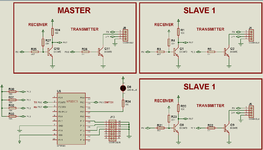gauravkothari23
Advanced Member level 2
Hi all.
I am trying to communicate on Uart on MS51FB9AE controller. the baud rate i am using is 1200
have also attached the circuit diagram. In circuit diagram, i have defined two slaves and 1 master and communication circuit using transistors.
the Communication is some thing like i have a button on the board and LED on both master and slave PCB's. when button is pressed from slave, master LED glows for 1 second and goes OFF. and again when the button is pressed from master once, the 1st slave LED will glow ON, and when 2nd time the button is pressed, the second slave LED will glow and so on. Total i have connected 15 slaves and 1 master. The slave have individual address which i have defined using J13 Connector.
The communication is done at the distance of approx 10 Metres using 4 core wires. The system is powered using 24V DC power supply and then 7805 which is not shown in the circuit.
My problem is when single slave in connected to master, it works well, but when 2 or more slave is connected, most of the times when the button is pressed from any slaves, master LED does not glow, but in the same case, when 15 slaves are connected, and button is pressed from master, the slave LED's glow properly,
so, i am facing a problem in data transmission from slave to master. but from master to slave works well. i even tried using Opto coupler PC817 instead of transistors, but still the same problem.
can anyone please suggest me any solution for this.
I am trying to communicate on Uart on MS51FB9AE controller. the baud rate i am using is 1200
have also attached the circuit diagram. In circuit diagram, i have defined two slaves and 1 master and communication circuit using transistors.
the Communication is some thing like i have a button on the board and LED on both master and slave PCB's. when button is pressed from slave, master LED glows for 1 second and goes OFF. and again when the button is pressed from master once, the 1st slave LED will glow ON, and when 2nd time the button is pressed, the second slave LED will glow and so on. Total i have connected 15 slaves and 1 master. The slave have individual address which i have defined using J13 Connector.
The communication is done at the distance of approx 10 Metres using 4 core wires. The system is powered using 24V DC power supply and then 7805 which is not shown in the circuit.
My problem is when single slave in connected to master, it works well, but when 2 or more slave is connected, most of the times when the button is pressed from any slaves, master LED does not glow, but in the same case, when 15 slaves are connected, and button is pressed from master, the slave LED's glow properly,
so, i am facing a problem in data transmission from slave to master. but from master to slave works well. i even tried using Opto coupler PC817 instead of transistors, but still the same problem.
can anyone please suggest me any solution for this.
